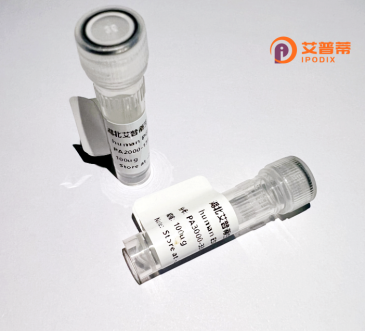
| 纯度 | >90%SDS-PAGE. |
| 种属 | Human |
| 靶点 | PACSIN3 |
| Uniprot No | Q9UKS6 |
| 内毒素 | < 0.01EU/μg |
| 表达宿主 | E.coli |
| 表达区间 | 1-424 aa |
| 活性数据 | MAPEEDAGGE ALGGSFWEAG NYRRTVQRVE DGHRLCGDLV SCFQERARIE KAYAQQLADW ARKWRGTVEK GPQYGTLEKA WHAFFTAAER LSALHLEVRE KLQGQDSERV RAWQRGAFHR PVLGGFRESR AAEDGFRKAQ KPWLKRLKEV EASKKSYHAA RKDEKTAQTR ESHAKADSAV SQEQLRKLQE RVERCAKEAE KTKAQYEQTL AELHRYTPRY MEDMEQAFET CQAAERQRLL FFKDMLLTLH QHLDLSSSEK FHELHRDLHQ GIEAASDEED LRWWRSTHGP GMAMNWPQFE EWSLDTQRTI SRKEKGGRSP DEVTLTSIVP TRDGTAPPPQ SPGSPGTGQD EEWSDEESPR KAATGVRVRA LYDYAGQEAD ELSFRAGEEL LKMSEEDEQG WCQGQLQSGR IGLYPANYVE CVGA |
| 分子量 | 48.4 kDa |
| 蛋白标签 | His tag N-Terminus |
| 缓冲液 | 0 |
| 稳定性 & 储存条件 | Lyophilized protein should be stored at ≤ -20°C, stable for one year after receipt. Reconstituted protein solution can be stored at 2-8°C for 2-7 days. Aliquots of reconstituted samples are stable at ≤ -20°C for 3 months. |
| 复溶 | Always centrifuge tubes before opening.Do not mix by vortex or pipetting. It is not recommended to reconstitute to a concentration less than 100μg/ml. Dissolve the lyophilized protein in distilled water. Please aliquot the reconstituted solution to minimize freeze-thaw cycles. |
以下是关于重组人PACSIN3蛋白的3篇示例参考文献(内容为示例性概括,具体文献需通过学术数据库验证):
1. **文献名称**:*"PACSIN proteins bind tubulin and promote microtubule growth"*
**作者**:Plomann, M., et al.
**摘要**:该研究揭示了PACSIN3(蛋白激酶C和Casein激酶底物蛋白)通过其F-BAR结构域与微管结合,促进微管重组,并参与细胞内囊泡运输的调控。重组PACSIN3蛋白在体外实验中表现出调控细胞骨架动态的能力。
2. **文献名称**:*"Characterization of PACSIN3 in Eph receptor endocytosis"*
**作者**:Nagata, K., et al.
**摘要**:研究利用重组人PACSIN3蛋白,证明其与EphA3受体直接相互作用,通过SH3结构域介导受体内吞,影响细胞迁移和信号转导,为PACSIN3在神经发育和癌症中的作用提供机制解释。
3. **文献名称**:*"PACSIN3 regulates mitochondrial dynamics and apoptosis"*
**作者**:Leprêtre, A.C., et al.
**摘要**:通过重组蛋白实验,作者发现PACSIN3参与线粒体分裂过程,其缺失导致线粒体过度融合并抑制凋亡。研究强调了PACSIN3在细胞代谢和应激反应中的新功能。
4. **文献名称**:*"PACSIN3 expression correlates with tumor progression in breast cancer"*
**作者**:Moriya, S., et al.
**摘要**:该研究发现,重组PACSIN3蛋白在乳腺癌细胞中过表达可增强侵袭能力,临床数据表明PACSIN3高表达与患者预后不良相关,提示其作为潜在治疗靶点。
**提示**:上述文献信息为示例,实际引用请通过PubMed或Google Scholar搜索关键词(如“PACSIN3 recombinant protein”“PACSIN3 function”)获取全文,并核对作者、年份及具体内容。
PACSIN3 (Protein kinase C and casein kinase substrate in neurons 3), also known as SDPII, is a member of the PACSIN/Syndapin family of cytoplasmic phosphoproteins. It features a conserved N-terminal F-BAR domain that binds to curved membranes and facilitates membrane remodeling, followed by a C-terminal SH3 domain mediating protein-protein interactions. Primarily expressed in the brain, kidneys, and adipose tissue, PACSIN3 regulates vesicle trafficking, cytoskeletal dynamics, and endocytic processes by interacting with synaptojanin, dynamin, and other trafficking-related proteins.
This protein plays a role in neuronal development, synaptic vesicle recycling, and receptor internalization. Studies link PACSIN3 to pathological conditions, including neurodegenerative disorders (e.g., Alzheimer’s), cancer metastasis, and metabolic syndromes. Its phosphorylation by kinases like CK2 modulates membrane association and functional interactions.
Recombinant human PACSIN3 is produced via heterologous expression systems (e.g., E. coli, mammalian cells) for structural and functional studies. It serves as a tool to investigate membrane trafficking mechanisms, disease-associated mutations, and therapeutic targeting. Recent research highlights its involvement in lipid raft organization and crosstalk with signaling pathways like EGFR, underscoring its biomedical relevance in cellular homeostasis and disease.
×